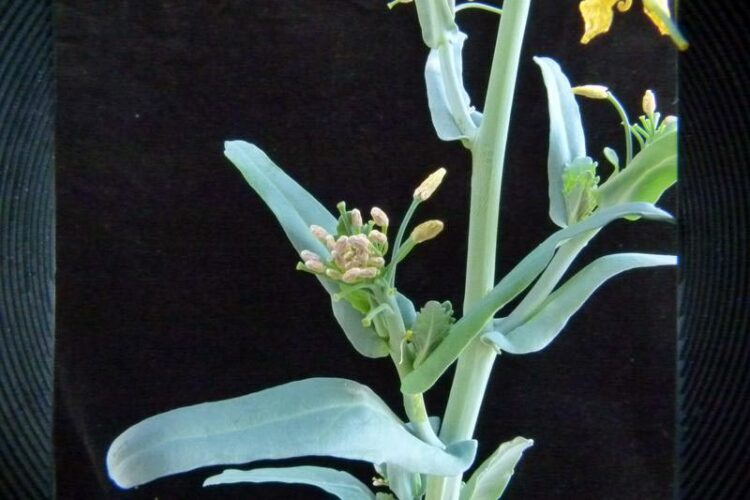Boron deficiency: oilseed rape reacts as with infection and pest infestation

Boron deficiency in rapeseed
(c) Manuela Désirée Bienert / TUM
Genetic mechanisms uncovered…
Boron deficiency has a devastating effect on oilseed rape and related plants. However, little is known about the underlying genetic mechanisms. A study shows that the response to persistent or short-term acute boron deficiency is similar to that to pests and infections. The results lay the foundation for breeding plants that can better cope with boron deficiency and for avoiding related yield losses.
- Oilseed rape reacts to boron deficiency during flowering in a similar way as to pests and infections
- Boron deficiency could become an increasing problem due to climate change
- Study lays the foundation for breeding more boron-efficient plants
Oilseed rape and related plants have a high boron requirement. A boron deficiency is often invisible on the outside of the affected plants for a long time, especially during vegetative stages. Nevertheless, it has serious consequences: First, the deficiency can inhibit root growth, and then later, the flowers can shrivel and die prematurely. This can result in enormous yield losses, especially when seeds or grains are the crop product of interest. In order to understand the underlying mechanisms, researchers from the Technical University of Munich (TUM), Bielefeld University and the Leibniz Institute of Plant Genetics and Crop Plant Research (IPK) have investigated which genes are active when boron is deficient and which are active when there is sufficient supply.
In a first step, the plants react to boron deficiency by producing more transport proteins that take up the nutrient. If deficiency persists, though, a stress reaction comes to the foreground in the developing and yield-relevant flowers. This resembles the reaction to pest attacks, wounding or infections and leads to the death of the affected flowers. It is still unknown whether the response is a targeted reaction of the plant to save resources for a potentially later flowering or whether the signaling pathway is triggered unintentionally. Both boron deficiency and infections damage plant cell walls. Cell wall damage could mimic infection and lead to a similar signal even in the absence of an infectious threat.
Boron-efficient plant varieties secure yields
Climate change could make boron shortages even more frequent in the future. In Central Europe, winters with more precipitation and prolonged dry periods in spring and summer are expected. As a result, water-soluble nutrients will be increasingly washed out in winter. In spring, the soil lacks moisture for the plants to absorb the nutrients. Under these conditions, it is difficult to compensate for the nutrient deficiency through targeted fertilization. “Either the boron in the soil does not reach the plant, or an already undetected boron deficiency leads to damage to the pathways for water and nutrients. As a result, applied boron can no longer be transported to the places in the plant where it is needed,” says Prof. Gerd Patrick Bienert from the TUM Chair of Crop Physiology.
Developing plant varieties that can either handle boron efficiently or are both water and boron efficient can secure future yields. The researchers’ findings contribute to identifying possible starting points in plant breeding. “The identification and breeding of boron efficiency mechanisms and the cultivation of boron-efficient varieties will become increasingly important in the context of climate change. A sufficient supply of boron is essential for the yield stability of crops, especially when water is scarce,” says crop researcher Bienert.
Wissenschaftliche Ansprechpartner:
Prof. Gerd Patrick Bienert
Technical University of Munich
Professorship of Crop Physiology
patrick.bienert@tum.de
https://www.mls.ls.tum.de/en/cropphys/home
Originalpublikation:
Verwaaijen, B., Alcock, T.D., Spitzer, C., Liu, Z., Fiebig, A., Bienert, M.D. et al. (2023) The Brassica napus boron deficient inflorescence transcriptome resembles a wounding and infection response. Physiologia Plantarum, 175(6), e14088. Available from: https://doi.org/10.1111/ppl.14088
Weitere Informationen:
Media Contact
All latest news from the category: Life Sciences and Chemistry
Articles and reports from the Life Sciences and chemistry area deal with applied and basic research into modern biology, chemistry and human medicine.
Valuable information can be found on a range of life sciences fields including bacteriology, biochemistry, bionics, bioinformatics, biophysics, biotechnology, genetics, geobotany, human biology, marine biology, microbiology, molecular biology, cellular biology, zoology, bioinorganic chemistry, microchemistry and environmental chemistry.
Newest articles

First-of-its-kind study uses remote sensing to monitor plastic debris in rivers and lakes
Remote sensing creates a cost-effective solution to monitoring plastic pollution. A first-of-its-kind study from researchers at the University of Minnesota Twin Cities shows how remote sensing can help monitor and…

Laser-based artificial neuron mimics nerve cell functions at lightning speed
With a processing speed a billion times faster than nature, chip-based laser neuron could help advance AI tasks such as pattern recognition and sequence prediction. Researchers have developed a laser-based…

Optimising the processing of plastic waste
Just one look in the yellow bin reveals a colourful jumble of different types of plastic. However, the purer and more uniform plastic waste is, the easier it is to…



